Spatio-Temporal Pattern of Urban Green Space in Chengdu Urban Center under Rapid Urbanization: From the Policy-Oriented Perspective
Abstract
:1. Introduction
2. Materials and Methods
2.1. Division of the Stages of Greening Policies
2.2. Indicator Selection
2.3. Data Source and Preprocessing
2.4. Methods
2.4.1. Definition of the Dynamic Urban Center Boundaries
2.4.2. Quantitative Characteristics of UGS
2.4.3. Qualitative Characteristics of UGS
3. Results
3.1. Overall Change Trends of UGS in Chengdu
3.2. Spatial Pattern of UGS in Chengdu
3.3. Relevance to Greening Policies
4. Discussion
4.1. Comparative Analysis
4.2. Opportunities and Challenges
4.3. Limitations
5. Conclusions
Author Contributions
Funding
Data Availability Statement
Conflicts of Interest
| 1 | Data source: https://www.kearney.com/industry/public-sector/global-cities/2022 (accessed on 31 January 2024) |
| 2 | Data source: https://data.cnki.net/yearBook/single?id=N2023070129 (accessed on 31 January 2024) |
| 3 | Notes: “One district” refers to the Ring City Ecological Zone and “two rings” pertain to both the Jinjiang Ring City Park and the 50-meter-wide green belt situated on either side of the Third Ring Road. The term “nine corridors” refers to the nine green traffic corridors formed by the main traffic arteries radiating outward from the center of the city while the term “seven rivers” refers to the green ecological corridors formed by seven tributary waterways (such as the Jinjiang River) within the highway around the city. Finally, “multiple parks” are manifested in various forms, such as comprehensive parks, specialized parks, country parks, and community parks. |
| 4 | Notes: Priority is given to ecology and low-to-medium development in the eastern region. A new urban form is being created through expansion in the southern region while better quality and more sustainable developments are achieved through control in the western region. Finally, the quality of regional cities is transformed in the northern region, industrial structure is upgraded, and the industrial capacity level is optimized in the central region. |
References
- Melchiorri, M.; Florczyk, A.J.; Freire, S.; Schiavina, M.; Pesaresi, M.; Kemper, T. Unveiling 25 years of planetary urbanization with remote sensing: Perspectives from the global human settlement layer. Remote Sens. 2018, 10, 768. [Google Scholar] [CrossRef]
- United Nations. World Urbanization Prospects: The 2018 Revision; Online Edition; United Nations: New York, NY, USA, 2018. [Google Scholar]
- Sun, L.Q.; Chen, J.; Li, Q.L.; Huang, D. Dramatic uneven urbanization of large cities throughout the world in recent decades. Nat. Commun. 2020, 11, 5366. [Google Scholar] [CrossRef]
- Johnson, M.T.J.; Munshi-South, J. Evolution of life in urban environments. Science 2017, 358, eaam8327. [Google Scholar] [CrossRef] [PubMed]
- Yang, C.; Zeng, W.; Yang, X. Coupling coordination evaluation and sustainable development pattern of geo-ecological environment and urbanization in Chongqing municipality, China. Sustain. Cities Soc. 2020, 61, 102271. [Google Scholar] [CrossRef]
- Shang, K.; Xu, L.; Liu, X.; Yin, Z.; Liu, Z.; Li, X.; Yin, L.; Zheng, W. Study of urban heat island effect in Hangzhou metropolitan area based on SW-TES algorithm and image dichotomous model. Sage Open 2023, 13, 21582440231208851. [Google Scholar] [CrossRef]
- Shang, K.; Chen, Z.; Liu, Z.; Song, L.; Zheng, W.; Yang, B.; Liu, S.; Yin, L. Haze prediction model using deep recurrent neural network. Atmosphere 2021, 12, 1625. [Google Scholar] [CrossRef]
- Watrobski, J.; Baczkiewicz, A.; Ziemba, E.; Salabun, W. Sustainable cities and communities assessment using the DARIA-TOPSIS method. Sustain. Cities Soc. 2022, 83, 103926. [Google Scholar] [CrossRef]
- Zoomers, A.; Van Noorloos, F.; Otsuki, K.; Steel, G.; van Westen, G. The rush for land in an urbanizing world: From land grabbing toward developing safe, resilient, and sustainable cities and landscapes. World Dev. 2017, 92, 242–252. [Google Scholar] [CrossRef]
- Huang, Y.Y.; Lin, T.; Zhang, G.Q.; Jones, L.; Xue, X.Z.; Ye, H.; Liu, Y.Q. Spatiotemporal patterns and inequity of urban green space accessibility and its relationship with urban spatial expansion in China during rapid urbanization period. Sci. Total Environ. 2022, 809, 151123. [Google Scholar] [CrossRef]
- Mwendwa, P.; Giliba, R.A. Benefits and challenges of urban green spaces. Chin. J. Popul. Resour. Environ. 2012, 10, 73–79. [Google Scholar] [CrossRef]
- Li, L.; Uyttenhove, P.; Van Eetvelde, V. Planning green infrastructure to mitigate urban surface water flooding risk–A methodology to identify priority areas applied in the city of Ghent. Landsc. Urban Plan. 2020, 194, 103703. [Google Scholar] [CrossRef]
- Massaro, E.; Schifanella, R.; Piccardo, M.; Caporaso, L.; Taubenböck, H.; Cescatti, A.; Duveiller, G. Spatially-optimized urban greening for reduction of population exposure to land surface temperature extremes. Nat. Commun. 2023, 14, 2903. [Google Scholar] [CrossRef] [PubMed]
- Reyes-Riveros, R.; Altamirano, A.; De la Barrera, F.; Rozas-Vásquez, D.; Vieli, L.; Meli, P. Linking public urban green spaces and human well-being: A systematic review. Urban For. Urban Green. 2021, 61, 127105. [Google Scholar] [CrossRef]
- McPhearson, T.; Cook, E.M.; Berbes-Blazquez, M.; Cheng, C.W.; Grimm, N.B.; Anderson, E.; Barbosa, O.; Chandler, D.G.; Chang, H.J.; Chester, M.V.; et al. A social-ecological-technological systems framework for urban ecosystem services. One Earth 2022, 5, 505–518. [Google Scholar] [CrossRef]
- Liu, Y.; Gao, Y.; Liu, L.; Song, C.; Ai, D. Nature-based solutions for urban expansion: Integrating ecosystem services into the delineation of growth boundaries. Habitat Int. 2022, 124, 102575. [Google Scholar] [CrossRef]
- Jensen, J.R.; Cowen, D.C. Remote sensing of urban/suburban infrastructure and socio-economic attributes. Photogramm. Eng. Remote Sens. 1999, 65, 611–622. [Google Scholar]
- Shahtahmassebi, A.R.; Li, C.L.; Fan, Y.F.; Wu, Y.N.; Lin, Y.; Gan, M.Y.; Wang, K.; Malik, A.; Blackburn, G.A. Remote sensing of urban green spaces: A review. Urban For. Urban Green. 2021, 57, 126946. [Google Scholar] [CrossRef]
- Kong, F.H.; Nakagoshi, N. Spatial-temporal gradient analysis of urban green spaces in Jinan, China. Landsc. Urban Plan. 2006, 78, 147–164. [Google Scholar] [CrossRef]
- Zhou, X.; Wang, Y.C. Spatial–temporal dynamics of urban green space in response to rapid urbanization and greening policies. Landsc. Urban Plan. 2011, 100, 268–277. [Google Scholar] [CrossRef]
- Chen, B.; Wu, S.B.A.; Song, Y.M.; Webster, C.; Xu, B.; Gong, P. Contrasting inequality in human exposure to greenspace between cities of Global North and Global South. Nat. Commun. 2022, 13, 636. [Google Scholar] [CrossRef]
- Ye, C.; Hu, L.; Li, M. Urban green space accessibility changes in a high-density city: A case study of Macau from 2010 to 2015. J. Transp. Geogr. 2018, 66, 106–115. [Google Scholar] [CrossRef]
- Sharifi, F.; Nygaard, A.; Stone, W.M. Heterogeneity in the subjective well-being impact of access to urban green space. Sustain. Cities Soc. 2021, 74, 103244. [Google Scholar] [CrossRef]
- Pu, R.; Landry, S. A comparative analysis of high spatial resolution IKONOS and WorldView-2 imagery for mapping urban tree species. Remote Sens. Environ. 2012, 124, 516–533. [Google Scholar] [CrossRef]
- Xu, L.; Liu, X.; Tong, D.; Liu, Z.; Yin, L.; Zheng, W. Forecasting urban land use change based on cellular automata and the PLUS model. Land 2022, 11, 652. [Google Scholar] [CrossRef]
- Labib, S.M.; Lindley, S.; Huck, J.J. Spatial dimensions of the influence of urban green-blue spaces on human health: A systematic review. Environ. Res. 2020, 180, 108869. [Google Scholar] [CrossRef]
- Gupta, K.; Kumar, P.; Pathan, S.K.; Sharma, K.P. Urban Neighborhood Green Index–A measure of green spaces in urban areas. Landsc. Urban Plan. 2012, 105, 325–335. [Google Scholar] [CrossRef]
- Zhou, T.Y.; Liu, H.M.; Gou, P.; Xu, N. Conflict or Coordination? measuring the relationships between urbanization and vegetation cover in China. Ecol. Indic. 2023, 147, 109993. [Google Scholar] [CrossRef]
- Faryadi, S.; Taheri, S. Interconnections of urban green spaces and environmental quality of Tehran. Int. J. Environ. Res. 2009, 3, 199–208. [Google Scholar]
- Santamouris, M.; Ban-Weiss, G.; Osmond, P.; Paolini, R.; Synnefa, A.; Cartalis, C.; Muscio, A.; Zinzi, M.; Morakinyo, T.E.; Ng, E.; et al. Progress in urban greenery mitigation science–assessment methodologies advanced technologies and impact on cities. J. Civ. Eng. Manag. 2018, 24, 638–671. [Google Scholar] [CrossRef]
- Engemann, K.; Pedersen, C.B.; Arge, L.; Tsirogiannis, C.; Mortensen, P.B.; Svenning, J.C. Residential green space in childhood is associated with lower risk of psychiatric disorders from adolescence into adulthood. Proc. Natl. Acad. Sci. USA 2019, 116, 5188–5193. [Google Scholar] [CrossRef]
- Harris, V.; Kendal, D.; Hahs, A.K.; Threlfall, C.G. Green space context and vegetation complexity shape people’s preferences for urban public parks and residential gardens. Landsc. Res. 2018, 43, 150–162. [Google Scholar] [CrossRef]
- Yang, J.; Huang, C.H.; Zhang, Z.Y.; Wang, L. The temporal trend of urban green coverage in major Chinese cities between 1990 and 2010. Urban For. Urban Green. 2014, 13, 19–27. [Google Scholar] [CrossRef]
- Hu, T.; Peng, J.; Liu, Y.; Wu, J.; Li, W.; Zhou, B. Evidence of green space sparing to ecosystem service improvement in urban regions: A case study of China’s Ecological Red Line policy. J. Clean. Prod. 2020, 251, 119678. [Google Scholar] [CrossRef]
- Pristeri, G.; Peroni, F.; Pappalardo, S.E.; Codato, D.; Masi, A.; De Marchi, M. Whose urban green? mapping and classifying public and private green spaces in Padua for spatial planning policies. ISPRS Int. J. Geo-Inf. 2021, 10, 538. [Google Scholar] [CrossRef]
- Wu, W.B.; Ma, J.; Meadows, M.E.; Banzhaf, E.; Huang, T.Y.; Liu, Y.F.; Zhao, B. Spatio-temporal changes in urban green space in 107 Chinese cities (1990–2019): The role of economic drivers and policy. Int. J. Appl. Earth Obs. Geoinf. 2021, 103, 102525. [Google Scholar] [CrossRef]
- Wu, Z.; Chen, R.; Meadows, M.E.; Sengupta, D.; Xu, D. Changing urban green spaces in Shanghai: Trends, drivers and policy implications. Land Use Policy 2019, 87, 104080. [Google Scholar] [CrossRef]
- Xu, Z.; Zhang, Z.; Li, C. Exploring urban green spaces in China: Spatial patterns, driving factors and policy implications. Land Use Policy 2019, 89, 104249. [Google Scholar] [CrossRef]
- Choi, J.; Kim, G. History of Seoul’s Parks and Green Space Policies: Focusing on Policy Changes in Urban Development. Land 2022, 11, 474. [Google Scholar] [CrossRef]
- Liu, S.; Zhang, X.; Feng, Y.; Xie, H.; Jiang, L.; Lei, Z. Spatiotemporal Dynamics of Urban Green Space Influenced by Rapid Urbanization and Land Use Policies in Shanghai. Forests 2021, 12, 476. [Google Scholar] [CrossRef]
- Zhong, J.L.; Li, Z.G.; Sun, Z.S.; Tian, Y.J.; Yang, F. The spatial equilibrium analysis of urban green space and human activity in Chengdu, China. J. Clean. Prod. 2020, 259, 120754. [Google Scholar] [CrossRef]
- Dong, Q.; Cai, J.; Chen, S.; He, P.; Chen, X. Spatiotemporal Analysis of Urban Green Spatial Vitality and the Corresponding Influencing Factors: A Case Study of Chengdu, China. Land 2022, 11, 1820. [Google Scholar] [CrossRef]
- Gao, X.; Huang, R.; Li, J.; Wang, C.; Lan, T.; Li, Q.; Deng, O.; Tao, Q.; Zeng, M. Temperature induces soil organic carbon mineralization in urban park green spaces, Chengdu, southwestern China: Effects of planting years and vegetation types. Urban For. Urban Green. 2020, 54, 126761. [Google Scholar] [CrossRef]
- Dong, Q.; Lu, H.; Luo, X.; He, P.; Li, D.; Wu, L.; Wei, Y.; Chen, X. Evaluation and Optimization of Green Space Fairness in Urban Built-Up Areas Based on an Improved Supply and Demand Model: A Case Study of Chengdu, China. Sustainability 2023, 15, 15014. [Google Scholar] [CrossRef]
- Zeng, Y.L.; Hao, D.L.; Park, T.; Zhu, P.; Huete, A.; Myneni, R.; Knyazikhin, Y.; Qi, J.B.; Nemani, R.R.; Li, F.; et al. Structural complexity biases vegetation greenness measures. Nat. Ecol. Evol. 2023, 7, 1790–1798. [Google Scholar] [CrossRef] [PubMed]
- Hmimina, G.; Dufrene, E.; Pontailler, J.Y.; Delpierre, N.; Aubinet, M.; Caquet, B.; Grandcourt, A.D.; Flechard, C.; Gross, P.; Heinesch, B. Evaluation of the potential of MODIS satellite data to predict vegetation phenology in different biomes: An investigation using ground-based NDVI measurements. Remote Sens. Environ. 2013, 132, 145–158. [Google Scholar] [CrossRef]
- Peng, D.; Wu, C.; Li, C.; Zhang, X.; Liu, Z.; Ye, H.; Luo, S.; Liu, X.; Hu, Y.; Fang, B. Spring green-up phenology products derived from MODIS NDVI and EVI: Intercomparison, interpretation and validation using National Phenology Network and AmeriFlux observations. Ecol. Indic. 2017, 77, 323–336. [Google Scholar] [CrossRef]
- Badgley, G.; Field, C.B.; Berry, J.A. Canopy near-infrared reflectance and terrestrial photosynthesis. Sci. Adv. 2017, 3, e1602244. [Google Scholar] [CrossRef] [PubMed]
- Ersi, C.; Bayaer, T.; Bao, Y.; Bao, Y.; Yong, M.; Lai, Q.; Zhang, X.; Zhang, Y. Comparison of phenological parameters extracted from SIF, NDVI and NIRv data on the Mongolian plateau. Remote Sens. 2023, 15, 187. [Google Scholar] [CrossRef]
- Yang, Z.Q.; Fang, C.L.; Li, G.D.; Mu, X.F. Integrating multiple semantics data to assess the dynamic change of urban green space in Beijing, China. Int. J. Appl. Earth Obs. Geoinf. 2021, 103, 102479. [Google Scholar] [CrossRef]
- Yang, J.; Huang, X. The 30 m annual land cover dataset and its dynamics in China from 1990 to 2019. Earth Syst. Sci. Data 2021, 13, 3907–3925. [Google Scholar] [CrossRef]
- Li, X.C.; Gong, P.; Zhou, Y.Y.; Wang, J.; Bai, Y.Q.; Chen, B.; Hu, T.Y.; Xiao, Y.X.; Xu, B.; Yang, J.; et al. Mapping global urban boundaries from the global artificial impervious area (GAIA) data. Environ. Res. Lett. 2020, 15, 094044. [Google Scholar] [CrossRef]
- Gong, P.; Li, X.C.; Wang, J.; Bai, Y.Q.; Cheng, B.; Hu, T.Y.; Liu, X.P.; Xu, B.; Yang, J.; Zhang, W.; et al. Annual maps of global artificial impervious area (GAIA) between 1985 and 2018. Remote Sens. Environ. 2020, 236, 111510. [Google Scholar] [CrossRef]
- Yang, J.; Dong, J.; Xiao, X.; Dai, J.; Wu, C.; Xia, J.; Zhao, G.; Zhao, M.; Li, Z.; Zhang, Y.; et al. Divergent shifts in peak photosynthesis timing of temperate and alpine grasslands in China. Remote Sens. Environ. 2019, 233, 111395. [Google Scholar] [CrossRef]
- Cai, D.L.; Fraedrich, K.; Sielmann, F.; Guan, Y.N.; Guo, S.; Zhang, L.; Zhu, X.H. Climate and vegetation: An ERA-Interim and GIMMS NDVI analysis. J. Clim. 2014, 27, 5111–5118. [Google Scholar] [CrossRef]
- Chen, B.; Nie, Z.; Chen, Z.Y.; Xu, B. Quantitative estimation of 21st-century urban greenspace changes in Chinese populous cities. Sci. Total Environ. 2017, 609, 956–965. [Google Scholar] [CrossRef]
- Chen, C.; Park, T.; Wang, X.H.; Piao, S.L.; Xu, B.D.; Chaturvedi, R.K.; Fuchs, R.; Brovkin, V.; Ciais, P.; Fensholt, R.; et al. China and India lead in greening of the world through land-use management. Nat. Sustain. 2019, 2, 122–129. [Google Scholar] [CrossRef]
- Zhao, J.J.; Chen, S.B.; Jiang, B.; Ren, Y.; Wang, H.; Vause, J.; Yu, H.D. Temporal trend of green space coverage in China and its relationship with urbanization over the last two decades. Sci. Total Environ. 2013, 442, 455–465. [Google Scholar] [CrossRef]
- Sun, C.; Lin, T.; Zhao, Q.; Li, X.; Ye, H.; Zhang, G.; Liu, X.; Zhao, Y. Spatial pattern of urban green spaces in a long-term compact urbanization process—A case study in China. Ecol. Indic. 2019, 96, 111–119. [Google Scholar] [CrossRef]
- Pang, B.; Zhao, J.; Zhang, J.; Yang, L. Calculating optimal scale of urban green space in Xi’an, China. Ecol. Indic. 2023, 147, 110003. [Google Scholar] [CrossRef]
- Chen, Y.; Men, H.; Ke, X. Optimizing urban green space patterns to improve spatial equity using location-allocation model: A case study in Wuhan. Urban For. Urban Green. 2023, 84, 127922. [Google Scholar] [CrossRef]
- Wan, J.; Li, Y.; Ma, C.; Jiang, T.; Su, Y.; Zhang, L.; Song, X.; Sun, H.; Wang, Z.; Zhao, Y.; et al. Measurement of coupling coordination degree and spatio-temporal characteristics of the social economy and ecological environment in the Chengdu–Chongqing urban agglomeration under high-quality development. Int. J. Environ. Res. Public Health 2021, 18, 11629. [Google Scholar] [CrossRef] [PubMed]
- Aryal, J.; Sitaula, C.; Aryal, S. NDVI threshold-based urban green space mapping from sentinel-2a at the Local Governmental Area (LGA) level of Victoria, Australia. Land 2022, 11, 351. [Google Scholar] [CrossRef]
- Ju, Y.; Dronova, I.; Delclòs-Alió, X. A 10 m resolution urban green space map for major Latin American cities from Sentinel-2 remote sensing images and OpenStreetMap. Sci. Data 2022, 9, 586. [Google Scholar] [CrossRef] [PubMed]
- Zhang, D.; Liu, H.; Yu, Z. Analysis on the Rationality of Urban Green Space Distribution in Hangzhou City Based on GF-1 Data. Sustainability 2023, 15, 12027. [Google Scholar] [CrossRef]
- Yang, Z.Q.; Fang, C.L.; Mu, X.F.; Li, G.D.; Xu, G.Y. Urban green space quality in China: Quality measurement, spatial heterogeneity pattern and influencing factor. Urban For. Urban Green. 2021, 66, 127381. [Google Scholar] [CrossRef]
- Kim, K.; Lee, C.K.; Kim, H.W. Understanding the Accessibility of Urban Parks and Connectivity of Green Spaces in Single-Person Household Distribution: Case Study of Incheon, South Korea. Land 2022, 11, 1441. [Google Scholar] [CrossRef]
- Wen, Z.; Zhang, S.; Yang, Y.; Zheng, X.; Song, Z.; Zhou, Y.; Hao, J. How does enclosed private residential green space impact accessibility equity in urban regions? A case study in Shenzhen, China. Urban For. Urban Green. 2023, 85, 127968. [Google Scholar] [CrossRef]
- Wu, L.; Kim, S.K.; Lin, C. Socioeconomic groups and their green spaces availability in urban areas of China: A distributional justice perspective. Environ. Sci. Policy 2022, 131, 26–35. [Google Scholar] [CrossRef]
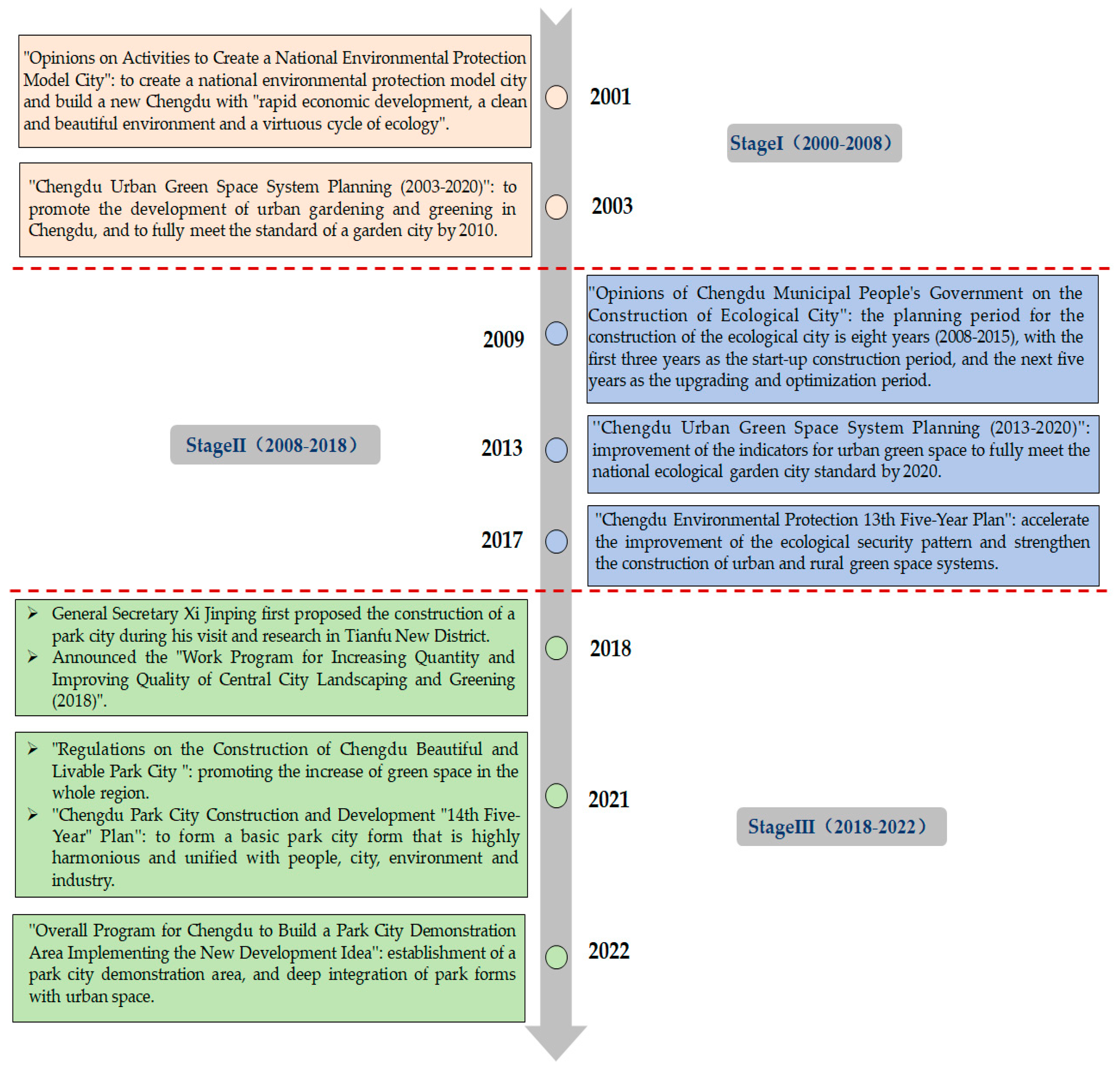
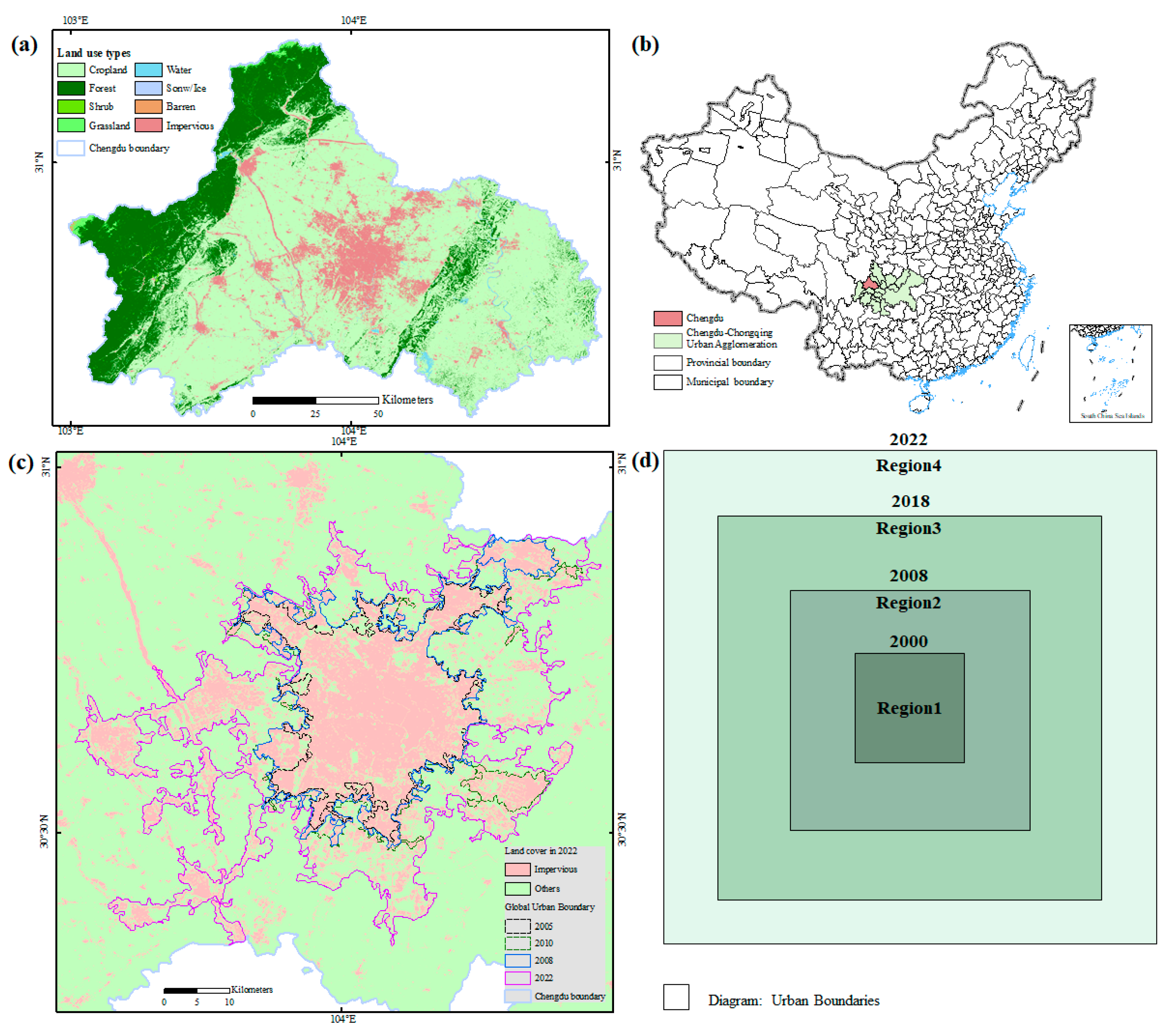
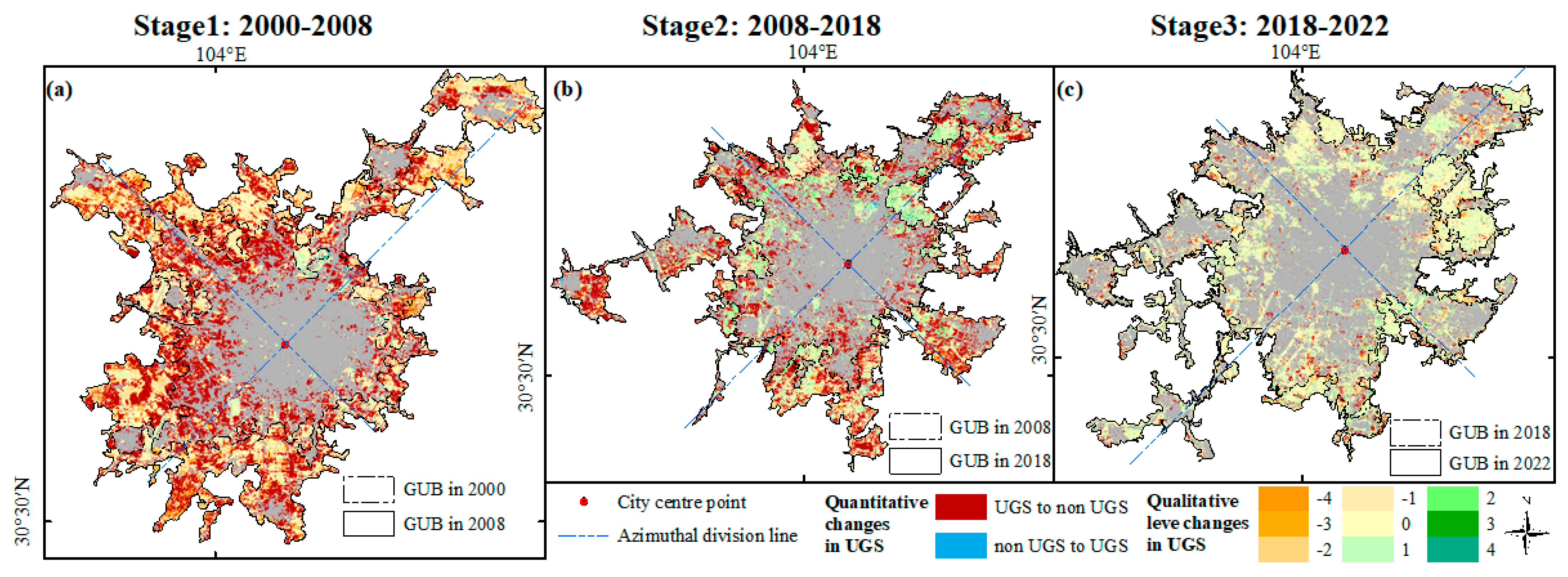
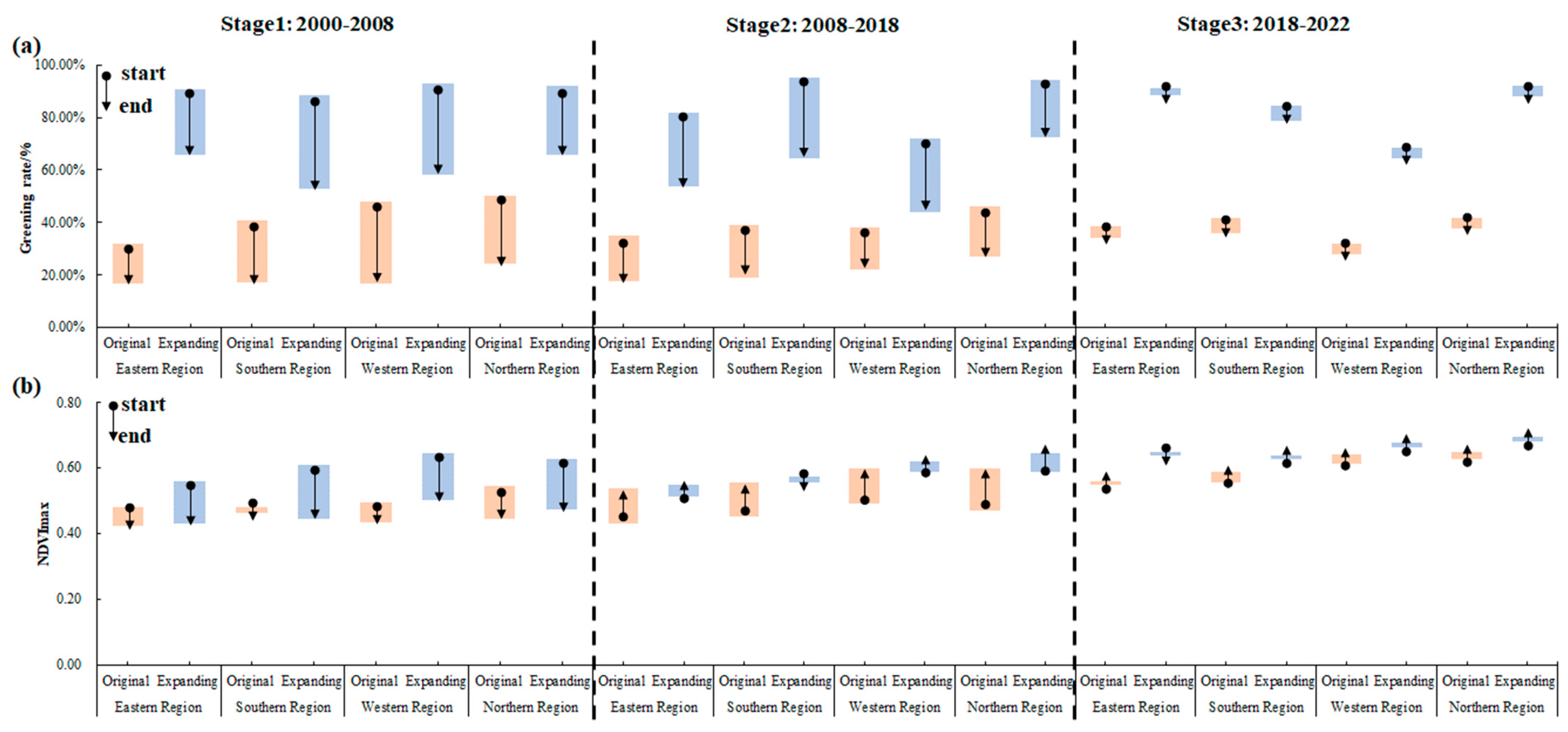
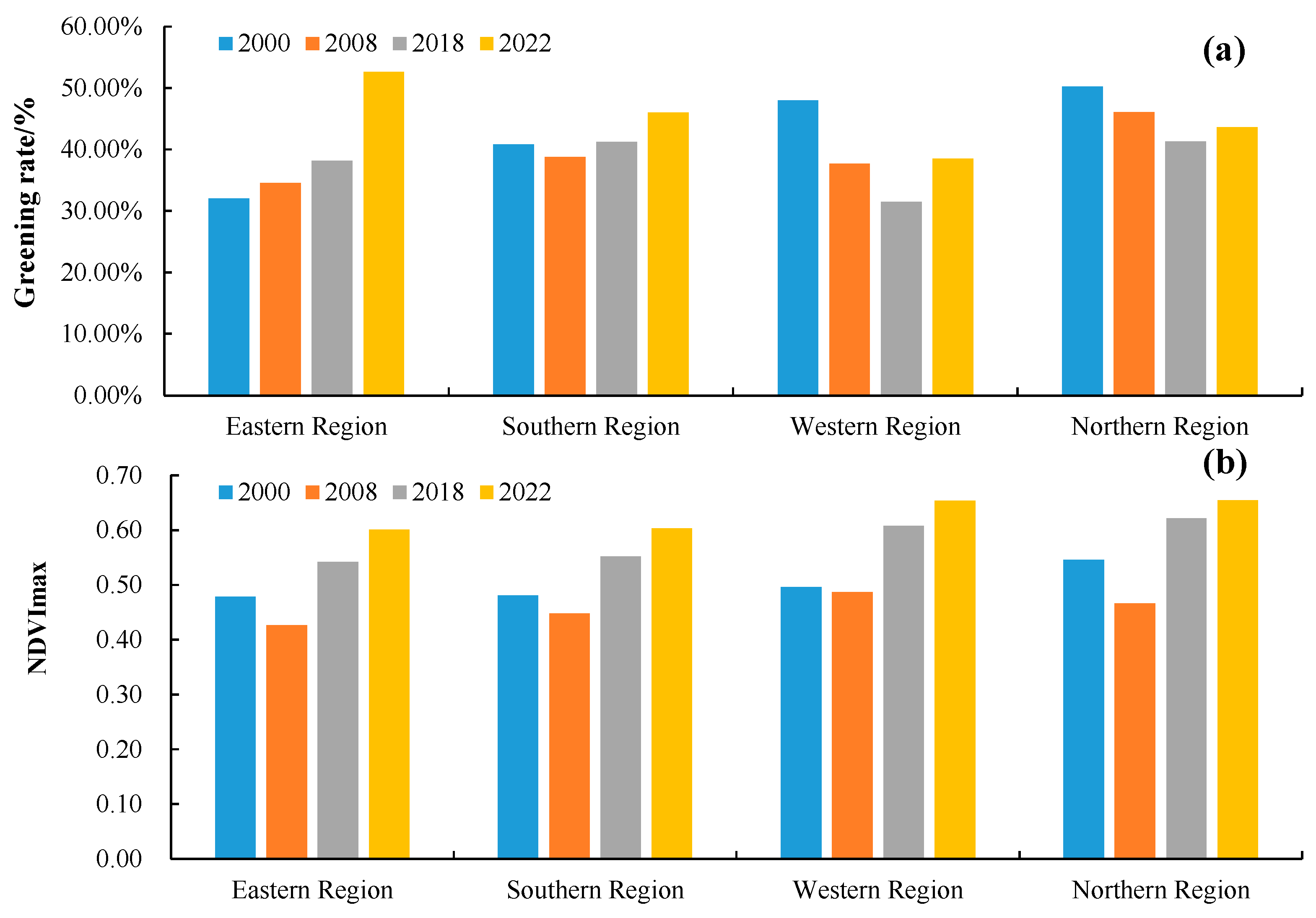
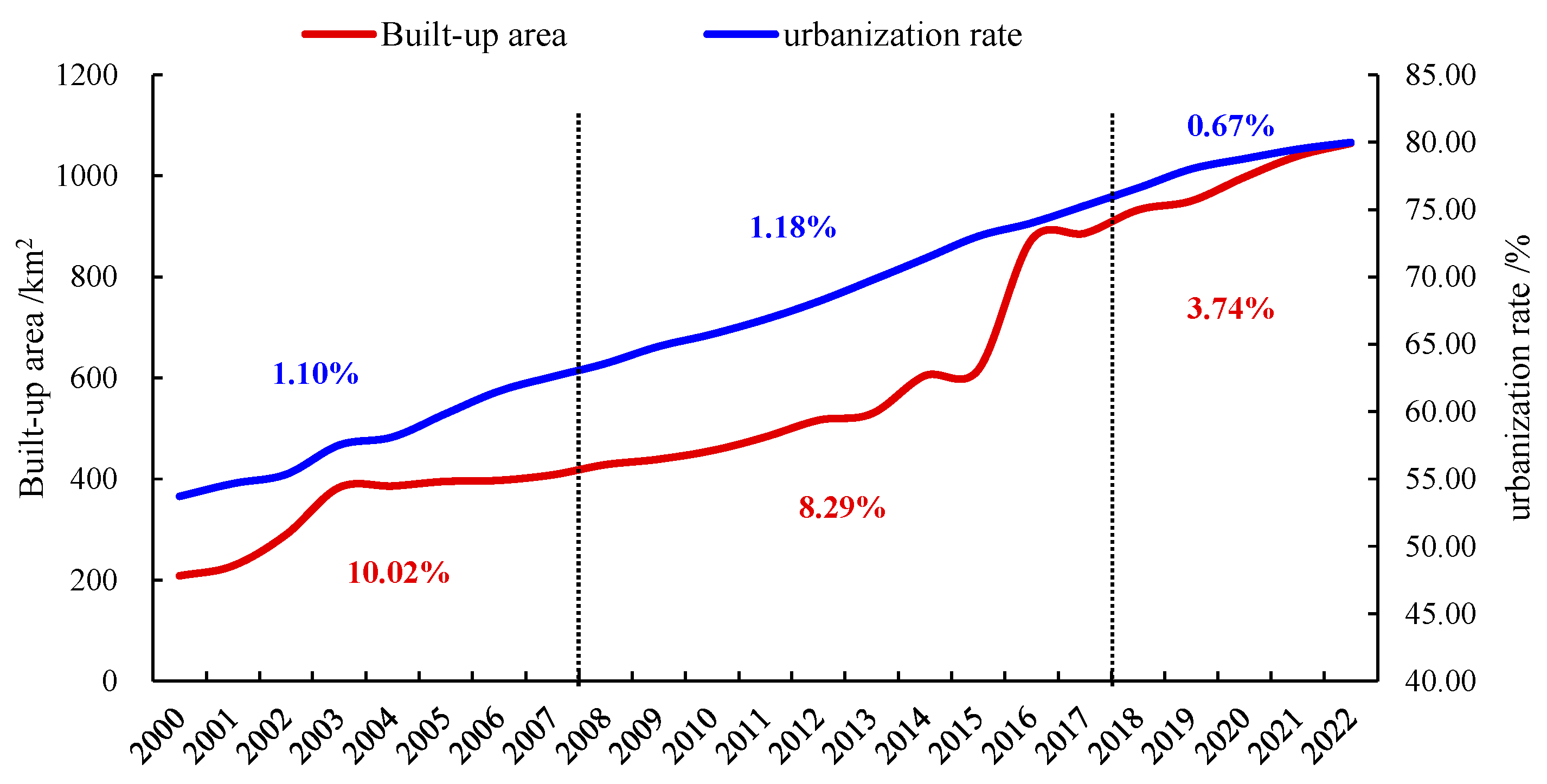
| Name | Resolution | Range Used in This Study | Data Sources | Notes |
|---|---|---|---|---|
| China land cover dataset, CLCD | 30 m | 2000, 2008, 2018, 2022 | Earth System Science Data | Evaluation of UGS quantity |
| Global urban boundary, GUB | 30 m | 2000, 2005, 2010, 2018 | Peng Cheng Laboratory | - |
| Global artificial impervious area, GAIA | 30 m | 2008, 2022 | Peng Cheng Laboratory | Access to GUB |
| NDVI | 30 m | 2000, 2008, 2018, 2022 | National Ecosystem Science Data Center | Evaluation of UGS quality |
| Quality Level | Grading Criteria | Description |
|---|---|---|
| 1 | 0.30 | Low quality |
| 2 | 0.300.45 | Medium-low quality |
| 3 | 0.60 | Medium quality |
| 4 | 0.75 | Medium-high quality |
| 5 | 1.00 | High quality |
| Stage1: 2000–2008 | Stage2: 2008–2018 | Stage3: 2018–2022 | 2022 | |||||
|---|---|---|---|---|---|---|---|---|
| Original Urban Area | Expanding Urban Area | Original Urban Area | Expanding Urban Area | Original Urban Area | Expanding Urban Area | Urban Center | ||
| Area (km2) | 442.64 | 462.21 | 904.85 | 752.37 | 1657.22 | 576.42 | 2233.64 | |
| Quantity | Start | 44.21% | 91.28% | 40.16% | 83.87% | 37.63% | 80.99% | 44.61% |
| End | 19.13% | 60.27% | 22.06% | 56.34% | 33.30% | 77.13% | ||
| Change | −25.08% | −31.01% | −18.10% | −27.53% | −4.33% | −3.86% | ||
| Quality | Start | 0.5092 | 0.6205 | 0.4629 | 0.5602 | 0.5842 | 0.6490 | 0.6280 |
| End | 0.4401 | 0.4699 | 0.5798 | 0.5863 | 0.6086 | 0.6520 | ||
| Change | −13.57% | −24.27% | 25.25% | 4.66% | 4.18% | 0.46% | ||
Disclaimer/Publisher’s Note: The statements, opinions and data contained in all publications are solely those of the individual author(s) and contributor(s) and not of MDPI and/or the editor(s). MDPI and/or the editor(s) disclaim responsibility for any injury to people or property resulting from any ideas, methods, instructions or products referred to in the content. |
© 2024 by the authors. Licensee MDPI, Basel, Switzerland. This article is an open access article distributed under the terms and conditions of the Creative Commons Attribution (CC BY) license (https://creativecommons.org/licenses/by/4.0/).
Share and Cite
Li, K.; Du, W.; Yang, Z.; Yan, H.; Mu, Y. Spatio-Temporal Pattern of Urban Green Space in Chengdu Urban Center under Rapid Urbanization: From the Policy-Oriented Perspective. Land 2024, 13, 443. https://doi.org/10.3390/land13040443
Li K, Du W, Yang Z, Yan H, Mu Y. Spatio-Temporal Pattern of Urban Green Space in Chengdu Urban Center under Rapid Urbanization: From the Policy-Oriented Perspective. Land. 2024; 13(4):443. https://doi.org/10.3390/land13040443
Chicago/Turabian StyleLi, Kelei, Wenpeng Du, Zhiqi Yang, Huimin Yan, and Yutong Mu. 2024. "Spatio-Temporal Pattern of Urban Green Space in Chengdu Urban Center under Rapid Urbanization: From the Policy-Oriented Perspective" Land 13, no. 4: 443. https://doi.org/10.3390/land13040443
APA StyleLi, K., Du, W., Yang, Z., Yan, H., & Mu, Y. (2024). Spatio-Temporal Pattern of Urban Green Space in Chengdu Urban Center under Rapid Urbanization: From the Policy-Oriented Perspective. Land, 13(4), 443. https://doi.org/10.3390/land13040443






